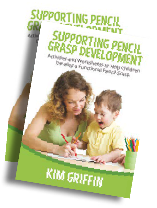Although a child needs many skills to be competent at handwriting, the first thing that is typically considered when they have difficulty writing is their pencil grip. This is, however, only one element of handwriting. There are many more, including language! In this article Occupational Therapist Kim Griffin, from GriffinOT, will explore the many components of handwriting and some support that may be helpful.
Component 1 – Fine motor and visual perception
Fine motor and visual perception skills form the foundation for handwriting. Initially, a child needs to be able to hold and control their pencil. Next, they need to be able to visually identify and recognise letters and words. Then, they need to know how to form letters and words in order to write them down. These are the core areas occupational therapists help with.
For children developing their pencil grasp, additional fine motor activities using their thumb, index and middle fingers can help. This includes water droppers, construction toys such as Duplo and Popoids, and playdough. Puzzles, matching games and reading support visual recognition.
Practice is a key element for learning to write letters and words. This can be done with paint, in the air, with chalk or white boards, and obviously with pens. Apps, such as Letter School and Writing Wizard, can also be useful.
Printed script is much easier for children to learn. In fact, most children in reception are not developmentally ready to learn cursive, despite it being the policy in some schools. Also, learning letters in formation groups (i.e. c, o, a, d, g, q) can be easier for children compared to learning letters in phonics groups (i.e. s, a, t, p, i, n). The UK National Handwriting Association has recently published new guidance for ‘Developing a Handwriting Policy’ which could be helpful if your school is reviewing its policies.
For older children struggling with the physical elements of handwriting, keyboarding or voice dictation would be a relevant option to consider.
Component 2 – Can the child understand the question?
The next thing a child needs to be able to do is understand the question. In early years classes this is often not a problem. There is continuous modelling and practise so children can see what they need to do, even if they can’t read or understand the question. However, understanding a question is a distinct skill which some children need to be taught. Using highlighters to find the relevant information in the question, and practising breaking a question down, can help these children.
Component 3 – Does the child have an idea for their answer?
Children typically fall into two categories here and it’s easy to separate them. Some children find writing their answer down really hard. However, if you ask them to tell you their answer they can talk for hours. Others don’t write their answer down, but, also can’t tell you an answer. These challenges need to be supported differently.
If the child has an answer and great ideas then they might find voice dictation helpful for larger pieces of work. Standard computer software (e.g. Android, Windows and Apple) is excellent and in many cases a special programme doesn’t necessarily need to be purchased. Voice dictation also makes the child independent with recording their ideas. Other options include using a scribe or writing down the answers for the child to copy.
The child who can’t tell you their answer needs a different approach. They might find mind mapping helpful to generate ideas. The map can then be used to create sentences and paragraphs. Often, children need a lot of practice at this before they can be independent. There is also a piece of software called Mindview which may be useful for older children. In addition, these children may benefit from sorting activities, where potential answers or ideas are given and they need to sort these for relevance.
And finally – what about spellings and composition?
Spelling and sentence composition are other elements of handwriting that go far beyond pencil grasp! Even if a child has a perfect tripod grasp, difficulty with spelling will be a barrier for them to be successful with handwriting. Teachers specialise in teaching spelling and I know there are specific programmes available to support spelling. To facilitate handwriting, one common strategy is to write the spelling out for the child to copy. Another teacher I worked with used to have the child make an attempt but then make a squiggly underline under the words they were unsure of. She called these ‘squiggly’ words. The strategy seemed to increase the children’s confidence and willingness to write, particularly for those who worried about being wrong.
For older children, again software could be useful. Standard autopredict software (e.g. Google, Android, Apple) is improving every year. The programme Clicker 7 is also designed specifically to help with spelling.
In conclusion, I hope this article will help you to look past pencil grip for children who are struggling with their handwriting. Whilst it is a foundation and useful focus early on, a child needs many other elements to be successful with their handwriting.
Author information
Kim Griffin is a paediatric occupational therapist. Her company GriffinOT delivers affordable online sensory training and motor skill development programmes to schools, teachers and parents. For more information visit on our programmes please visit https://www.GriffinOT.com/SL

Please login to view this content
Login